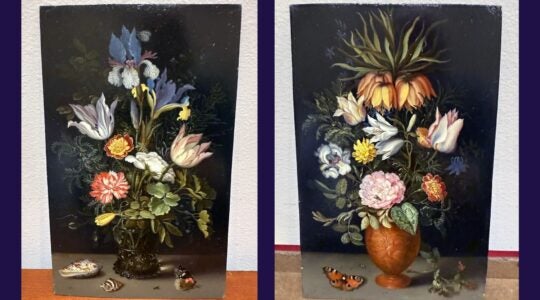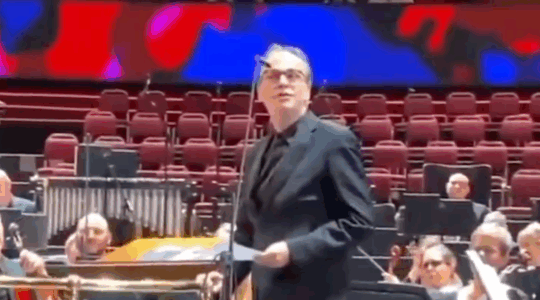He’s been written up in The New York Times. The Christian Science Monitor called him the "Indiana Jones of rabbis." For years, Maryland’s Rabbi Menachem Youlus has regaled congregations across the country with his dramatic tales of rescuing and restoring Torah scrolls from the ashes of the Holocaust.
Now, a lengthy piece in the Washington Post has stopped just shy of calling Youlus a fraud — a significant development not only because it punctures the rabbi’s mythic image, but because as a Torah scribe, Youlus is supposed to be above reproach.
Here’s the most damning section:
In the spring of 2008, Central Synagogue, a prominent temple in Manhattan, dedicated another of Youlus’s rescued Torahs. This one came with an iconic name attached. Youlus says he secretly unearthed it in Oswiecim — the Polish town made infamous by its German name, Auschwitz. Oswiecim Jews, Youlus said, buried this Torah in a metal box in their cemetery to save it from the Nazis. More than six decades later, he told the New York Times, he located the scroll with a metal detector and dug it up. But it was missing four parchment panels. The local Jews removed these panels, he said, before burying the Torah, and later somehow spirited the fragments into the camp. Youlus says he placed an ad in a local newspaper offering to pay for parchment with Hebrew writing on it. Miraculously, a priest — a former Auschwitz prisoner — responded the very next day and sold him four panels that proved to be an exact match.
Central Synagogue’s rabbi, Peter Rubinstein, acknowledges that he was initially baffled as to how the parchment had come into the camp. But he did not seek an independent appraisal or ask for documentation. Rubinstein says he ultimately trusted Youlus, and he trusted the man who had purchased the Torah and wanted to donate it to Central Synagogue.
That donor was David Rubenstein (no relation to the rabbi) of the Carlyle Group, the D.C.-based private equity firm. The billionaire philanthropist — who has lent a copy of the Magna Carta to the National Archives — was not a member of Central Synagogue. But he came well recommended by a congregant: Arthur Levitt, the former Securities and Exchange Commission chairman. "That’s how the connection was made," Rabbi Rubinstein recalls. "That’s how the world works." As he remembers, donor David Rubenstein "said he wanted exposure for the scroll in New York."
So with great fanfare, the Torah from Auschwitz was dedicated in New York on Holocaust Remembrance Day 2008. Months later, on the Jewish New Year, the congregation again took the Torah down from its imposing two-tiered ark. In his sermon, Rabbi Rubinstein repeated the story of the Torah’s wondrous rescue from the killing fields of Oswiecim. Reflecting back on that homily, he says: "Remember, this was two days after the market dropped 700 points, and I was trying to talk about retrenching, not financial retrenching, [but] what are the things that are the anchors of our lives."
Reached for comment about the Auschwitz Torah, Poland’s chief rabbi, American Michael Schudrich, responds in an e-mail: "I cannot confirm anything that Menachem has written. I do not know the people he is referring to." Youlus’s discovery is also a mystery to Tomasz Kuncewicz, director of the Auschwitz Jewish Center, which cares for the Oswiecim cemetery, and to Dorota Wiewiora, head of the tiny Jewish community still living in the region. She is dismayed at the idea that someone would dig among human remains. And, Wiewiora adds, if such a Torah really was dug up, it would rightfully be the property of her community. "No one would sell it. It’s not ethical."
Asked why no one in Oswiecim knew about his ad hoc archaeological dig, Youlus changes major details of the story he told Central Synagogue and the New York Times. He says the box containing the Torah was not made of metal, though he can’t say exactly what the material was. Youlus says he simply took an educated guess as to where it was buried, hired a crew to dig and found it in the ground beyond the old cemetery walls. As for the priest who supplied the missing parchment panels, Youlus didn’t find him through a classified ad. He says his great aunt — friends with an unidentified Polish cardinal — helped find the priest. What was the priest’s name? "I have no idea," Youlus says. According to the Archdiocese of Krakow, the last local priest who survived Auschwitz died years before Youlus says he arrived on the scene in 2004.
In a 3-hour interview, Youlus is unable to provide a single name, date, place, photograph or document to back up the Auschwitz stories or any of the others. He says that until Save a Torah was founded in 2004, he kept no records. He refers all requests for documentation since then to the foundation’s president, investment banker Rick Zitelman of Rockville.
But in a late December meeting at The Washington Post, Zitelman, 54, shows no documentation for any of the scrolls, despite requests. Zitelman says the only paperwork he gets from Youlus is an invoice the rabbi himself writes up for each Torah. He says Youlus does not submit any airline tickets or hotel receipts for overseas missions. So where does he think Youlus finds the Torahs? "It’s my understanding these Torahs come from various locations, including monasteries, museums, antique shops, private owners and other places like that," he says.
JTA has documented Jewish history in real-time for over a century. Keep our journalism strong by joining us in supporting independent, award-winning reporting.





